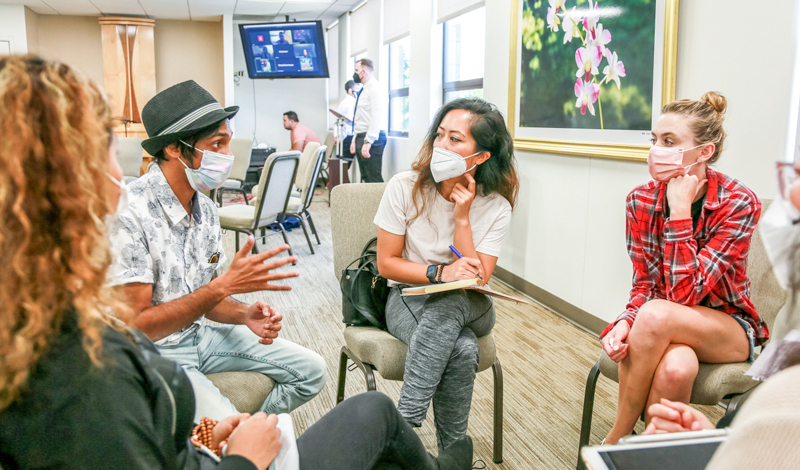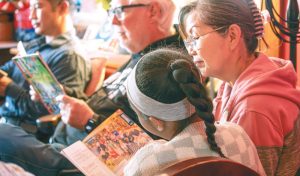The following is SGI President Ikeda’s monthly encouragement published in the October edition of The Daibyakurenge, the Soka Gakkai’s study journal.
In this existence,
joyfully walk
the unsurpassed way that is
fragrant with beautiful flowers of humanity,
together with smiling friends.
We develop our characters and grow as individuals through our interactions with others. The Italian thinker Giuseppe Mazzini (1805–72) declared: “A more and more intimate and extended association with our fellow men is the means by which our strength will be multiplied.”[1] It is in human connections and cooperative efforts that we can find hope for breaking through the deadlocks that weigh heavily on contemporary society.
Founding Soka Gakkai president Tsunesaburo Makiguchi, who gave his life for his beliefs, left us a precious key for fostering friendship and understanding and opening the door to infinite happiness: the discussion meeting.
It is at discussion meetings that many people encounter Nichiren Daishonin’s Buddhism for the first time. It is at discussion meetings where the warm support and encouragement of fellow members inspire us to tackle and overcome personal problems and challenges. Discussion meetings establish oases of joy and security in our communities and make it possible for us to create immeasurable value in an unceasing rhythm, day in and day out, month after month. Discussion meetings—and, indeed, all Soka Gakkai meetings—are gatherings of Buddhas, in complete accord with the Lotus Sutra and the writings of Nichiren Daishonin. They are gatherings respectworthy beyond compare.
“The Benefits of Responding with Joy” (18th) chapter of the Lotus Sutra describes the boundless benefits that are to be gained by asking someone to attend a Buddhist assembly, actually bringing a person there, or warmly welcoming visitors and offering them a seat. In view of the sutra, it is also clear that our members who offer their homes for Gakkai meetings will receive immense benefits.
In a letter sent to Toki Jonin, one of the central figures among his lay followers, Nichiren Daishonin sternly cautions: “You must not spend your lives in vain and regret it for ten thousand years to come.”[2] And he adds in the postscript: “I hope all those who are serious in their resolve will gather in one place and listen to this letter [being read].”[3]
As disciples, it’s not enough that we simply read the Daishonin’s writings or our mentor’s guidance in quiet solitude. We should have the spirit to gather together in one place with our fellow practitioners. The earnest resolve in making an effort to assemble in this way has the power to defeat negativity and devilish functions. And by joining together with others to study the Daishonin’s writings and our mentor’s guidance, we can summon forth lionlike courage to undertake the task of actualizing the great vow of kosen-rufu.
Even if beforehand we don’t really feel like attending a meeting, once we get there we invariably find ourselves refreshed and invigorated. Meetings have a wondrous power to draw us toward happiness and victory.
My mentor, second Soka Gakkai president Josei Toda, who took every single meeting very seriously, said, “The Lotus Sutra urges us to treat fellow practitioners with the same respect we would show toward Buddhas.”[4] Our focus is the happiness of each person, and working together with the members. We must never forget that starting point. We have to make our meetings the most enjoyable, meaningful, and harmonious in all the world, meetings that are open and unpretentious.
Mr. Toda placed special importance on having members share experiences at meetings. Such experiences brim with the members’ vibrant life force and the dynamic power of faith that has enabled them to defeat devilish functions and triumph over obstacles. They serve as a perennial source of inspiration, bringing genuine hope and courage to others. Nichiren Daishonin writes: “When one who is able to show clearly visible proof in the present expounds the Lotus Sutra, there also will be persons who will believe.”[5]
In the early days of our movement, with youthful passion and enthusiasm, I also shared my experiences of successfully challenging my human revolution, and thereby stirred up a groundswell of propagation. Bunkyo Chapter was advancing by leaps and bounds, and I fondly recall one exciting discussion meeting at which almost 50 of the guests present expressed their wish to begin practicing the Daishonin’s Buddhism.
Clark Strand, a respected American journalist and writer specializing in religious topics, has commented: “Sharing such experiences builds faith, faith builds lives, and collectively those lives can change society.”[6] He also observed: “As long as the Soka Gakkai preserves this discussion model, its religious ethos will remain new.”[7]
In Côte d’Ivoire in Africa, some 900 discussion meetings are held every month. Chanting for the peace and prosperity of their country, the members there are welcoming many guests to their lively gatherings. The growth in youth division membership has been especially conspicuous.
Now is the time for capable new leaders to dynamically take action for kosen-rufu!
I am reminded of the words of my mentor: “Regard every Gakkai meeting, large or small, as important. Everything starts from the actual members who attend these meetings. As such, the success of these meetings opens the way to our victory in all spheres.”
Our Soka movement for kosen-rufu,
members brightly
advancing arm in arm
in joyous and triumphant unity,
accords with the Buddha’s decree.
References
- Joseph Mazzini, The Duties of Man and Other Essays (London: J. M. Dent and Sons, Ltd., 1955), p. 75. ↩︎
- The Writings of Nichiren Daishonin, vol. 1, p. 622. ↩︎
- Ibid. ↩︎
- See The Lotus Sutra and Its Opening and Closing Sutras, p. 365. ↩︎
- The Writings of Nichiren Daishonin, vol. 1, p. 512. ↩︎
- From an article published in Japanese in Daisanbunmei, January 2008 issue. ↩︎
- From an article published in Japanese in Daibyakurenge, June 2010 issue. ↩︎
You are reading {{ meterCount }} of {{ meterMax }} free premium articles





